
Citizen Kane is a 1941 American drama film produced and directed by Orson Welles, who also co-wrote the screenplay with Herman J. Mankiewicz. The picture was Welles's first feature film. Considered by many critics, filmmakers, and fans to be the greatest film ever made, Citizen Kane was voted number 1 in five consecutive British Film Institute Sight & Sound polls of critics, and it topped the American Film Institute's 100 Years ... 100 Movies list in 1998, as well as its 2007 update. Nominated for Academy Awards in nine categories, it won an Academy Award for Best Writing by Herman J. Mankiewicz and Welles. Citizen Kane is particularly praised for Gregg Toland's cinematography, Robert Wise's editing, Bernard Herrmann's music, and its narrative structure, all of which have been considered innovative and precedent-setting.
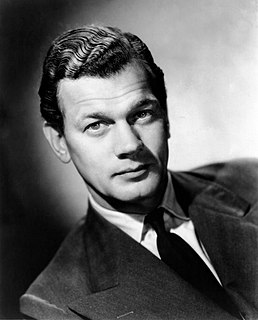
Joseph Cheshire Cotten Jr. was an American film, stage, radio and television actor. Cotten achieved prominence on Broadway, starring in the original stage productions of The Philadelphia Story and Sabrina Fair.

George Orson Welles was an American actor, director, screenwriter and producer who is remembered for his innovative work in radio, theatre and film. He is considered one of the greatest filmmakers of all time.
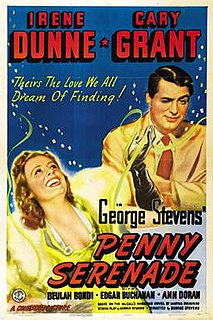
Penny Serenade is a 1941 American melodrama film directed by George Stevens starring Irene Dunne and Cary Grant as a loving couple who must overcome adversity to keep their marriage and raise a child. Grant was nominated for the Academy Award for Best Actor for his performance.

Bernard Herrmann was an American composer of Russian-Jewish descent best known for his work in composing for motion pictures. As a conductor, he championed the music of lesser-known composers.

The Campbell Playhouse (1938–1940) is a live CBS radio drama series directed by and starring Orson Welles. Produced by Welles and John Houseman, it was a sponsored continuation of The Mercury Theatre on the Air. The series offered hour-long adaptations of classic plays and novels, as well as adaptations of popular motion pictures.
Oja Kodar is a Croatian actress, screenwriter and director known as Orson Welles's partner during the later years of his life.

Paul Stewart was an American character actor, director and producer who worked in theatre, radio, films and television. He frequently portrayed cynical and sinister characters throughout his career.
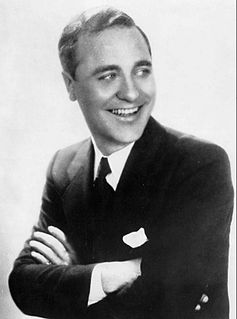
Wayne King was an American musician, songwriter, and bandleader with a long association with both NBC and CBS. He was referred to as "the Waltz King" because much of his most popular music involved waltzes; "The Waltz You Saved for Me" was his standard set-closing song in live performance and on numerous radio broadcasts at the height of his career. King's innovations included converting Carrie Jacobs-Bond's "I Love You Truly" from its original 2
4 time over to 3
4.
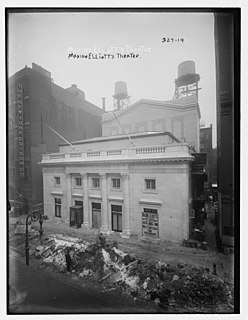
Maxine Elliott's Theatre was originally a Broadway theatre located at 109 West 39th Street in Manhattan. Built in 1908, it was designed by architect Benjamin Marshall of the Chicago-based firm Marshall and Fox, who modeled the façade after the Neoclassical Petit Trianon in Versailles. In later years, it was known as WOR Mutual Radio Theatre (1941–1944), CBS Radio Playhouse No. 5 (1944–1948), and CBS Television Studio No. 44 or CBS Television Studio Studio 51 (1948–1956). The theater was demolished in 1960 to make way for the Springs Mills Building.

Lurene Tuttle was an American character actress and acting coach, who made the transition from vaudeville to radio, and later films and television. Her most enduring impact was as one of network radio's more versatile actresses. Often appearing in 15 shows per week, comedies, dramas, thrillers, soap operas, and crime dramas, she became known as the "First Lady of Radio".
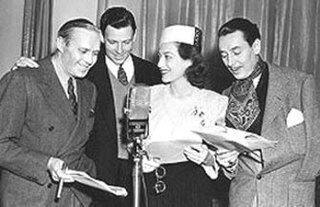
The Screen Guild Theater is a radio anthology series broadcast from 1939 until 1952 during the Golden Age of Radio. Leading Hollywood stars performed adaptations of popular motion pictures. Originating on CBS Radio, it aired under several different titles including The Gulf Screen Guild Show, The Gulf Screen Guild Theater, The Lady Esther Screen Guild Theater and The Camel Screen Guild Players. Fees that would ordinarily have been paid to the stars and studios were instead donated to the Motion Picture Relief Fund, and were used for the construction and maintenance of the Motion Picture Country House.
Author's Playhouse is an anthology radio drama series created by Wynn Wright, that aired on Mutual in 1940–1941, and on the NBC Blue Network from March 5, 1941, until October 1941. It then moved to the NBC Red Network where it was heard until June 4, 1945. Philip Morris was the sponsor between 1942 and 1943.
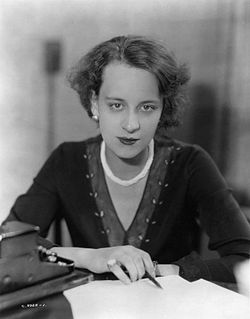
Georgia Belden Backus was an American character actress on stage, radio and screen. She was also a writer, director and producer of radio dramas. In 1930 she was named dramatic director of the Columbia Broadcasting System, to guide the development of the new art of the radio play. A member of the repertory company presenting Orson Welles's Mercury Theatre radio programs, she played supporting roles in some 30 films during the 1940s and 1950s. Her first screen credit was Citizen Kane (1941), in which she played the severe assistant in the Thatcher library. Her career was ended by the Hollywood blacklist.
The Mercury Wonder Show for Service Men was a 1943 magic-and-variety stage show by the Mercury Theatre, produced by Orson Welles and Joseph Cotten as a morale-boosting entertainment for US soldiers in World War II. Directed by Welles, the show starred Welles, Cotten, Agnes Moorehead and Rita Hayworth, whose part was later filled by Marlene Dietrich. Jean Gabin also worked on the show backstage, as a propman. The show ran to 150 minutes.

The Orson Welles Show (1941–42), also known as The Orson Welles Theater, Orson Welles and his Mercury Theater and the Lady Esther Show, was a live CBS Radio series produced, directed and hosted by Orson Welles. Broadcast Mondays at 10 p.m. ET, it made its debut September 15, 1941. Its last broadcast was February 2, 1942.

This is a comprehensive listing of the radio programs made by Orson Welles. Welles was often uncredited for his work, particularly in the years 1934–1937, and he apparently kept no record of his broadcasts.
Radio is what I love most of all. The wonderful excitement of what could happen in live radio, when everything that could go wrong did go wrong. I was making a couple of thousand a week, scampering in ambulances from studio to studio, and committing much of what I made to support the Mercury. I wouldn't want to return to those frenetic 20-hour working day years, but I miss them because they are so irredeemably gone.

This is a comprehensive listing of the theatre work of Orson Welles.
There isn't one person, I suppose, in a million, who knows that I was ever in the theatre.
Beatrice Giuditta Welles is an American former child actress, known for her roles in the film Chimes at Midnight (1966) and the documentary travelogue In the Land of Don Quixote (1964). The daughter of American filmmaker Orson Welles and Italian countess Paola Mori, she is a former model, radio and TV personality, founder of a cosmetics line and designer of handbags and jewelry. She administers the estate of Orson Welles.
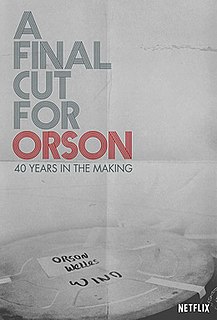
A Final Cut for Orson: 40 Years in the Making is a 2018 American documentary short, directed by Ryan Suffern, revolving around the completion of The Other Side of the Wind, directed by Orson Welles. It offers a glimpse behind the scenes into the complicated process of recovering and completing what Welles had intended to be his Hollywood comeback film in the 1970s. The documentary short and The Other Side of the Wind were produced by Frank Marshall and Filip Jan Rymsza.
















